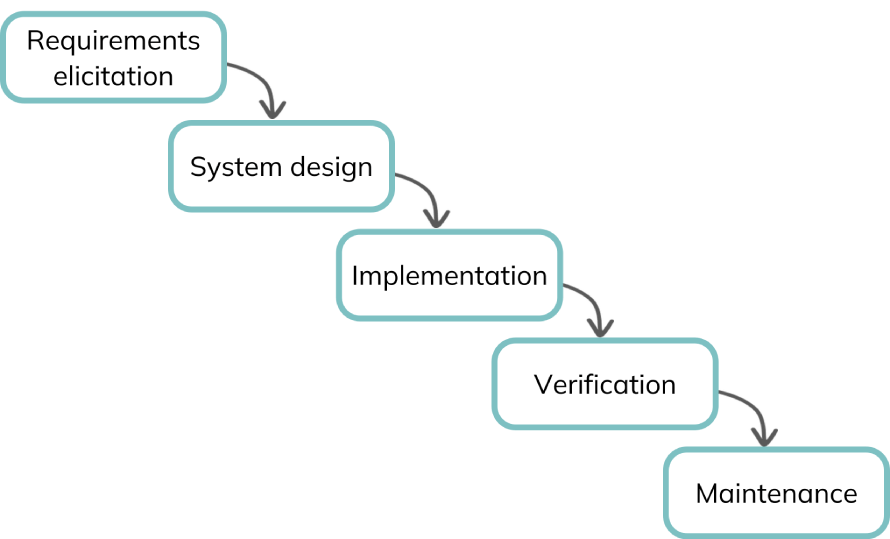
Introduction to the waterfall method

The waterfall method is a sequential approach to managing projects. This methodology follows a linear progression through distinct phases:
- Requirements elicitation
- Design
- Implementation
- Verification
- Maintenance.
Each phase must be completed before moving to the next, ensuring thorough documentation and planning. Key characteristics include:
- Rigid structure
- Comprehensive documentation
- Clear milestones
- Predictable timelines.
Unlike Agile methodologies, which embrace flexibility and iterative development, waterfall maintains a fixed scope throughout the project. This traditional approach suits projects with well-defined requirements and minimal changes expected during development.
While less adaptable than agile, waterfall provides a structured framework for managing complex projects with specific endpoints and regulatory compliance needs.
Waterfall phases
The waterfall method follows a structured sequence of phases, each building upon the previous one. Let’s explore these phases in detail:
Requirements elicitation
This initial phase involves collecting and documenting all project requirements, defining project scope and objectives, identifying stakeholders and their expectations and creating a detailed specification document.
System design
Based on the requirements, the team develops system architecture, user interface designs, database schemas and detailed technical specifications.
Implementation
During this phase, developers write code according to the design specifications, follow coding standards and best practices and create unit tests for individual components.
Verification
Testers rigorously evaluate the system by executing test cases based on requirements, performing integration and system testing, identifying and reporting bugs and verifying bug fixes and retesting.
Once testing is complete, the team:
- Prepares the production environmentn
- Migrates data if necessary
- Deploys the system to users
- Provides user training and documentation.
Maintenance and support
After deployment, ongoing activities include:
- Monitoring system performance
- Addressing user-reported issues
- Implementing minor enhancements
- Providing technical support to users.
Each phase in the waterfall process must be completed before moving to the next. This approach ensures thorough documentation and reduces the risk of missing critical requirements. However, it can be inflexible if requirements change mid-project. The sequential nature of waterfall demands meticulous planning and clear communication throughout the development lifecycle.
Benefits of the waterfall method
Waterfall project management offers several advantages that make it a preferred choice for certain types of projects. Let’s examine the key benefits:
Clear project structure and timeline
The sequential nature of waterfall provides:
- Well-defined phases with clear start and end points
- A structured timeline for project completion
- Easily communicable milestones to stakeholders.
Comprehensive documentation
Waterfall emphasises thorough documentation, resulting in detailed project requirements and specifications, clear design documents for future reference and valuable historical records for similar projects.
Predictable costs and resource allocation
The upfront planning in waterfall allows for accurate budget estimation, efficient allocation of resources throughout the project lifecycle and minimised unexpected expenses.
Easier tracking and progress assessment
Waterfall’s structured approach facilitates clear progress indicators at each phase, simplified reporting to stakeholders and easy identification of bottlenecks or delays.
Reduced risk through upfront planning
Comprehensive planning at the outset helps:
- Identify potential risks early in the project
- Develop mitigation strategies before implementation begins
- Minimise costly changes during later stages.
These benefits make waterfall particularly suitable for projects with well-defined requirements and minimal expected changes. The methodology’s structured approach provides a solid foundation for managing complex projects, especially in industries with strict regulatory compliance needs.
Limitations of the waterfall method
While waterfall methodology offers structure, it also presents several challenges. Understanding these limitations is crucial for effective project management:
Limited flexibility for changes
The rigid structure of waterfall can make accommodating changes difficult once a phase is complete, lead to costly revisions if requirements shift and inhibit innovation during development.
Limited flexibility for changes
Waterfall’s sequential nature results in late-stage user feedback, potentially missing market needs, reduced opportunities for early product validation and increased risk of developing features that users don’t want.
Potential for longer delivery times
The methodology can lead to extended project timelines due to comprehensive planning, delays in delivering working software to end-users and slower time-to-market compared to iterative approaches.
Challenges with customer collaboration
Waterfall can create barriers by limiting customer involvement after the requirements phase, reducing opportunities for ongoing stakeholder input and potentially misaligning the final product with evolved customer needs.
Risk of late-stage issues and rework
The linear progression may result in:
- Critical issues discovered late in development
- Costly and time-consuming rework
- Difficulty in addressing fundamental flaws near project completion.
These limitations highlight why waterfall may not be suitable for all projects, particularly those with evolving requirements or in dynamic markets. Recognising these challenges helps project managers decide when to consider alternative methodologies or adapt the waterfall approach to mitigate these risks.
Waterfall vs Agile methods
Understanding the differences between waterfall and agile methods is crucial for choosing the right approach for your project. Let’s compare these two methodologies across several key aspects:
Key differences in approach
Career path example:
| Waterfall | Agile |
| Linear, sequential | Iterative, incremental |
| Fixed scope | Flexible scope |
| Long-term planning | Short-term planning |
| Comprehensive documentation | Minimal documentation |
Flexibility and adaptability
Waterfall
- Rigid structure with defined phases
- Difficult to accommodate changes once a phase is complete
- Best for projects with stable requirements.
Agile
- Highly flexible, embracing change throughout the project
- Adapts easily to evolving requirements
- Suitable for projects in dynamic environments.
Customer involvement and feedback
Waterfall
- Limited customer involvement after initial requirements gathering
- Feedback primarily at project completion.
Agile
- Continuous customer collaboration throughout the project
- Regular feedback and adjustments based on customer input.
Team structure and collaboration
Waterfall
- Hierarchical team structure
- Specialised roles with limited cross-functional work.
Agile
- Self-organising, cross-functional teams
- Emphasises collaboration and shared responsibility.
Risk management and quality control
Waterfall
- Upfront risk identification and mitigation planning
- Quality control primarily at project end.
Agile
- Continuous risk assessment and mitigation
- Ongoing quality control through regular testing and reviews.
Both methodologies have their strengths and weaknesses. Waterfall offers structure and predictability, making it suitable for projects with well-defined requirements and stable environments. Agile, on the other hand, provides flexibility and adaptability, making it ideal for projects with evolving requirements or uncertain outcomes. The choice between waterfall and agile depends on various factors, including project complexity, team dynamics, and organisational culture.
When to use the waterfall method
While agile methodologies have gained popularity, waterfall remains a valuable approach in certain scenarios. Understanding when to apply waterfall can lead to successful project outcomes.
Projects with well-defined requirements
Waterfall is ideal for projects where:
- Requirements are clear and unlikely to change
- Stakeholders have a precise vision of the end product
- The project scope is well-understood from the outset.
Industries with strict regulatory compliance
Regulated industries benefit from waterfall’s structured approach healthcare and medical device development, aerospace and defence projects and financial services with stringent compliance needs.
These sectors require extensive documentation and adherence to specific protocols.
Large-scale, complex projects with fixed timelines
Waterfall suits projects with multiple interdependent components, long development cycles and strict deadlines and budget constraints.
Examples include infrastructure projects or enterprise-wide system implementations.
Projects with limited customer involvement during development
Waterfall is appropriate when:
- Customer input is primarily needed at the beginning and end
- The development process requires minimal user feedback
- The end-user’s needs are well-understood and stable.
In these scenarios, waterfall’s linear progression allows for focused development without frequent interruptions.
Choosing waterfall for suitable projects can lead to efficient execution and successful delivery. However, it’s crucial to carefully assess project characteristics and organisational needs before committing to this methodology. When applied appropriately, waterfall provides a structured framework for managing complex projects with predictable outcomes.
Waterfall best practices
To maximise the effectiveness of waterfall project management, consider these best practices:
Thorough requirements gathering and documentation
To ensure a successful project, start by gathering and documenting all requirements thoroughly. This involves conducting comprehensive stakeholder interviews, Creating detailed functional specifications, develop clear, measurable acceptance criteria and using formal sign-off procedures for requirements documents.
Effective communication and stakeholder management
To manage a project effectively, ensure clear communication and stakeholder engagement. This involves establishing regular status meetings and progress reports, clearly define roles and responsibilities for all team members, maintaining open channels for stakeholder feedback and using visual aids like Gantt charts to communicate project timelines.
Rigorous testing and quality assurance
To ensure a high-quality product, it’s crucial to develop a comprehensive testing strategy early in the project, implement multiple levels of testing (unit, integration, system, user acceptance), allocate sufficient time and resources for thorough quality assurance and document and track all defects and their resolutions.
Change management and scope control
Effective change management and scope control are vital for project success. Start by implementing a formal change request process, assessing the impact of proposed changes on timeline, budget, and resources, maintaining a change log to track all approved modifications and communicate changes and their impacts to all stakeholders.
Continuous monitoring and reporting
- Regularly track progress against the project plan
- Use earned value management to assess project performance
- Conduct periodic risk assessments and mitigation planning
- Provide timely and accurate reports to stakeholders.
By adhering to these best practices, project managers can enhance the likelihood of successful project delivery using the waterfall methodology. These strategies help maintain structure, improve communication, and ensure quality throughout the project lifecycle.
Waterfall tools and techniques
Effective waterfall project management relies on various tools and techniques to ensure smooth execution:
Gantt charts and project timelines
- Visualise project phases and dependencies
- Track progress against planned schedules
- Identify potential bottlenecks and resource conflicts.
Work Breakdown Structures (WBS)
- Decompose complex projects into manageable tasks
- Define clear deliverables and milestones
- Facilitate accurate resource allocation and estimation.
Critical path analysis
- Identify the sequence of crucial tasks affecting project duration
- Determine the minimum time needed to complete the project
- Focus on activities that directly impact the project timeline.
Project management software solutions
- Centralise project documentation and communication
- Automate task assignments and progress tracking
- Generate reports and analytics for informed decision-making.
These tools and techniques enhance project visibility, streamline communication, and improve overall project control. By leveraging these resources, project managers can effectively navigate the structured approach of waterfall methodology.
Conclusion
Recap of key points
Waterfall project management offers:
- Clear structure and timeline
- Comprehensive documentation
- Predictable costs and resource allocation.
However, it has limitations:
- Limited flexibility for changes
- Delayed feedback and product validation.
Final thoughts on relevance
Despite the rise of Agile methodologies, waterfall remains relevant in specific scenarios:
- Projects with well-defined requirements
- Industries with strict regulatory compliance
- Large-scale, complex projects with fixed timelines.
By understanding its strengths and weaknesses, project managers can make informed decisions about when to employ waterfall methodology. In the right context, waterfall continues to be a valuable approach for successful project delivery in modern software development.
FAQs
What are the main differences between waterfall and agile methodologies?
Waterfall is sequential and rigid, whilst agile is iterative and flexible. Waterfall emphasises upfront planning, whereas agile adapts to changing requirements.
Can waterfall and agile methodologies be combined?
Yes, hybrid approaches exist, combining elements of both methodologies to suit specific project needs.
How long does a typical waterfall project take?
Project duration varies widely, ranging from months to years, depending on scope and complexity.
What are the biggest challenges in waterfall project management?
Major challenges include managing changes, addressing late-stage issues, and maintaining stakeholder engagement throughout the project.
Is waterfall still relevant in today’s fast-paced software development environment?
Waterfall remains relevant for projects with well-defined requirements, strict regulatory compliance needs, or in industries where changes are costly.
Infographic









